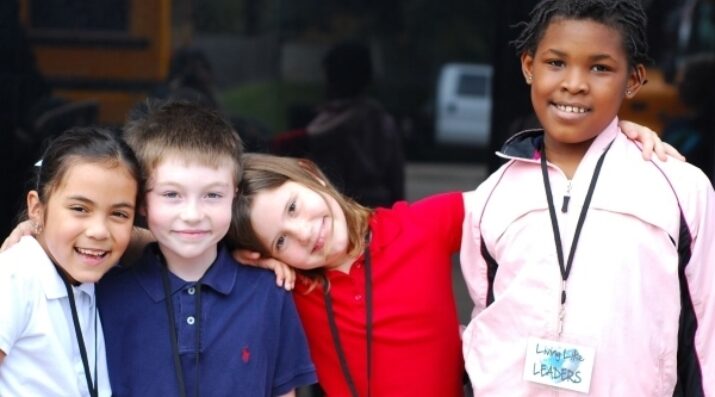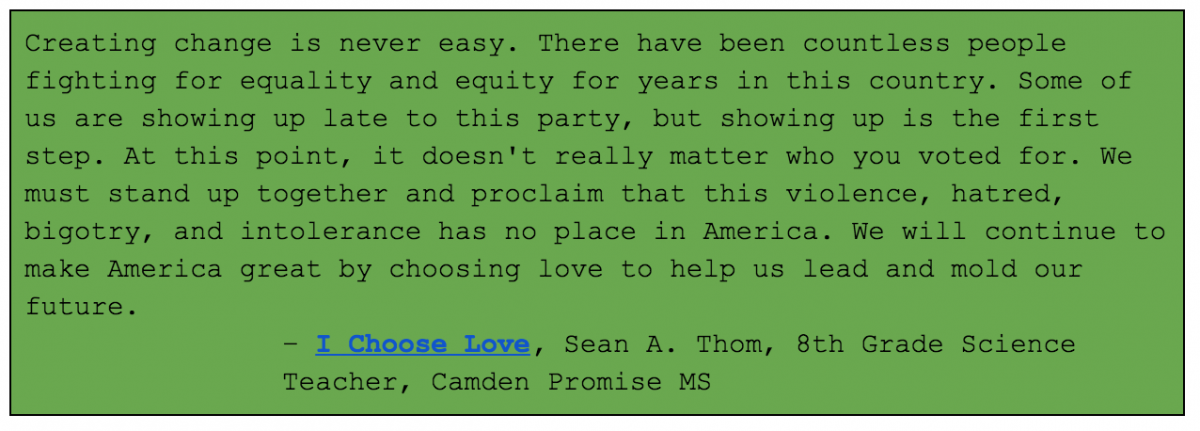Designing for Equity
Teachable Times: Equity in Next Generation Learning
Topics

Together, educators are doing the reimagining and reinvention work necessary to make true educational equity possible. Student-centered learning advances equity when it values social and emotional growth alongside academic achievement, takes a cultural lens on strengths and competencies, and equips students with the power and skills to address injustice in their schools and communities.
Practitioner's Guide to Next Gen Learning
Is equity our collective purpose, the “why” we all share? Find inspiration on the role of student agency, social-emotional learning & teaching for equity.

Knowing Our Why
The election has created many teachable moments for educators and parents alike and maybe caused each of us to reflect on what we value, what really matters, and why. So, before we discuss the “what”—the content in this piece—let’s revisit our “why” with comedian Michael Jr.
Thanks to Bryan Setser, Matchbook Learning, for this share!
We believe, for NGLC schools and partners, equity is the emotion, passion, and purpose animating the why of creating next gen learning designs. In a previous post, we explained our shift in equity focus from implicit to explicit, and our motivations for curating and creating the equity toolkit. Moving forward, knowing our why is what motivates continued use of equity tools and a deeper dive into living our questions with this purpose in mind.
Ask Students. Then Listen.

Source: Facebook
Today’s K-12 students can’t yet vote in our political system, but they can and do vote with their feet and their voices in our classrooms. Now may be the best opportunity to double down on making time to ask and listen to students as this 6th grade teacher did in a post-election NPR segment (2:55 min). Listening to each other and sharing our stories is the basis of forming relationship bonds and community-building. The strength of knowing each other as members of a community helps us design for equity in our shared learning. Next gen schools are leading a paradigm shift to activate student agency as a way of organizing learning. Schools like Da Vinci engage students in their hiring practice while students in Oakland Unified schools engage directly in culture building. Today may be the perfect time to rethink how our models can embrace more student decision making—from food choices to tech policy—in daily school operations, governance, and policy. School is a great place for students to practice community decision making and to see, feel, and learn from the direct consequences of their choices.
Elevating Culture, Kindness, Connection

Source: CASEL Core SEL Competencies
As a post-election reflection, what is the status, role, and execution of our commitment to social-emotional learning? What’s the real value of these skills? Rather than a “nice to have” element of the learning environment that operates in service to raising achievement, NGLC upholds social-emotional skills as worthy in and of themselves and on equal footing with content mastery. Most next gen schools agree that learning social-emotional competencies are important. Schools like Valor, Brooklyn Lab, and Thrive explicitly teach social and emotional skills as part of an essential preparation for citizenship, and for collaborating and communicating in cross-cultural and multidisciplinary settings.
Social-emotional skills define adult workplace cultures as much as school culture and are the basis for creating belonging which ultimately supports diversity. According to a recent Harvard Business Review feature, “creating a wide sense of belonging can become the competitive advantage for any [organization].” The recommended strategies appear deceptively simple. Investing personal time in relationship-building and valuing people and their stories creates experiences that “feel good.” And felt experience is what we remember. These foundational social-emotional connections create magnetic, safe, and creative cultures where people can be themselves and do their best work.
Teaching for Equity
Post election, many next gen teachers are engaging students in purposeful learning dialogue with each other and ensuring that respectful interactions remain the norm. It’s also true that on the whole, the next gen learning community (including NGLC and EDUCAUSE) could use more diversity in our teaching and administrative teams. How important is it for our school communities to broadly reflect student, community, or global diversity? What are we doing about it? These questions will only gain in relevance as the U.S. reflects the global population and continues to become less White.

We can be more creative and intentional about our hiring referrals and recruitment practices. Addressing our implicit bias takes conscious effort and persistence. When pressed for time, we turn to the known entities, and unless our networks are diverse (and most aren’t), we’re not going to get the kind of applicants we seek to create strong and diverse teams. That’s why the startup Jopwell was created to help tech companies locate diverse talent. The K-12 system could benefit from similar talent strategies to help schools better reflect the communities they serve. NGLC Regional Partners such as CityBridge Foundation, New Schools New Orleans, and Oakland have been designing fellowships to serve part of this need and are turning to strategic local partnerships to intentionally develop diverse talent.
At the organizational level, implicit bias can also manifest in school policies, practices, and structures governing the conditions for learning.

School teams have to make a concerted effort to engage parents and students for the purposes of listening and learning. Design processes and reflective practices help to shift the discourse from “blaming and shaming” parents and students to taking personal responsibility for the wellbeing of each student. These shifts create opportunities to redesign practices that are oppressive or detrimental to students and to school culture.
We know that a caring and skilled teacher can create equitable environments and impact the overall learning experience for students. Herein lies the power of our beliefs. We also know the opposite is true. Our post-election reflection asks if we need to invest in our own professional learning to ensure we are developing and using the skills characteristic of an equity lens and mindset. Skills for cultural relevancy. Skills for designing and leading for equity.
The National Equity Project has developed a set of competencies to guide us:

When working with teachers, Finessa Ferrell of the Colorado Education Initiative recommends Zaretta Hammond’s book, Culturally Responsive Teaching and the Brain. She asserts that developing our own capacity for caring comes from not only understanding how we perceive our students, but also appreciating how they may be perceiving and relating to us. We can only connect with students by demonstrating our own understanding of their perspective. Empathy helps us find these critical heart-based connections so that students feel cared for and know they matter to us.
According to the National Equity Project, part of doing equity work means “interrupting inequitable practices, examining biases, and creating inclusive school environments for all.” Post election, we’ve never had a more clear indicator of the need to build our essential skills and strengthen our community’s shared commitments to equity.
Resources
- For more inspiration on getting clear about your “why,” watch Simon Sinek’s Ted Talk or visit his site: https://www.startwithwhy.com/
- A complete set of social-emotional learning competencies is available from CASEL: http://www.casel.org/core-competencies/
- For more on changing discourse and designing for equity, read Caroline Hill and colleagues’ equityXdesign article on Medium
- Follow the National Equity Project blog to keep up on equity topics and resources
Related Posts
- Equity in Next Generation Learning - Over the past year, the NGLC network has explored what equity means in the context of next gen learning. Here’s what’s emerging from this personal & professional exercise.
- Leading and Designing for Equity in Oakland - In our blog series on equity, we’ve periodically featured the work of regional partners. In this post, we allow our gaze to fall upon some bright and colorful blooms maturing in the Oakland ecosystem.
- Finding True North: A Joyful Learning Experience at Valor Collegiate Academy - Do you equate your work with joy on a daily basis? One charter school has created just that kind of environment—for its students and faculty.
- Designing for Social Emotional Learning - Schools pursuing successful SEL outcomes require three essential design elements. Learn how Two Rivers Public Charter School in Washington D.C. is incorporating them into its curriculum.




